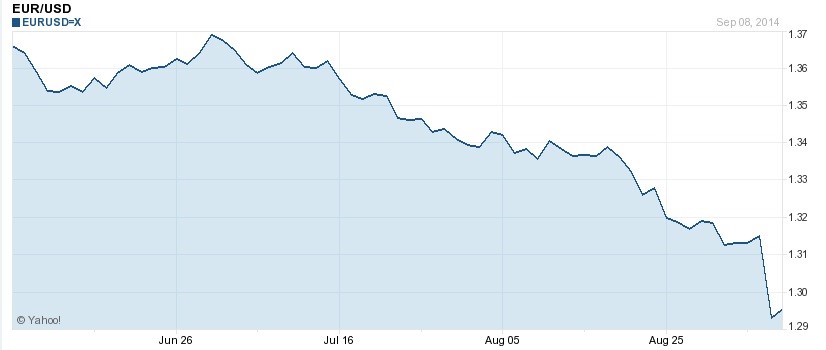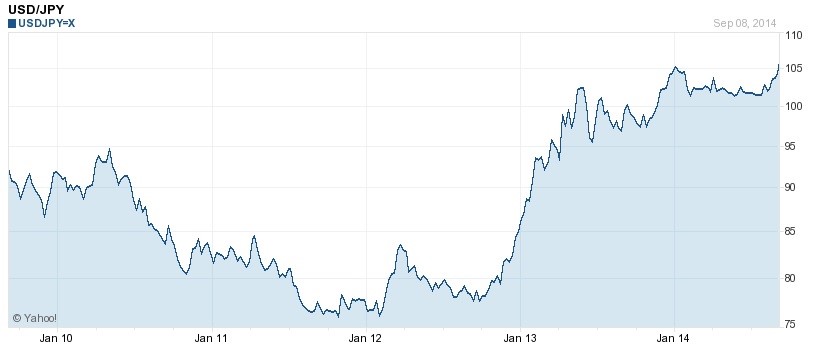The USD Gains Ground After the ECB Lowers Rates
Mario Draghi recently announced that new monetary policy measures would be adopted by the European Central Bank (ECB). The 18-nation bloc is currently facing deflationary pressures, pockets of persistently high unemployment, and low levels of investment spending. The economic situation has been impacted by poor GDP performance year on year by leading European nations such as Germany, France, Spain, Italy and Portugal. The net effect of lagging economic performance resulted in accommodative policies being adopted by the ECB on Thursday the 4th September.
Analysts were taken completely by surprise when the president of the ECB announced quantitative easing measures – upwards of €1 trillion - for the Eurozone. The asset purchases are designed to inject liquidity into the Eurozone to help drive economic activity and accelerate the velocity of money flow. By doing this, it is hoped that banks and other lenders will issue more credit facilities to customers. However monetary policy changes alone cannot spur economic growth without the concomitant adoption of structural reforms.
How Monetary Policies Affect Exchange Rates
It is especially important to understand why monetary policy measures were adopted by the ECB. For starters, deflation was weighing heavily on member countries and dragging their economies down. The net effect is a weaker EUR/USD exchange rate. It should be remembered that while the Eurozone is fixed on monetary easing, the US is moving in an entirely different direction. The US will soon end its policy of quantitative easing thereby driving up interest rates as money supply decreases. The effect of a slowdown in QE ultimately causes a greater demand for money which gives rise to increased interest rates.
One of the most heavily traded currency pairs at Banc De Binary – a leading financial broker – is the EUR/USD pair. The complex relationship between currencies relies on a series of interdependent and/or conflicting factors. The main determinants of cross-currency exchange rates are interest rates and the relative supply of currencies. Many other factors come into the equation but for the purposes of illustration these are most significant. In this currency pair, one euro will be worth a variable amount of dollars. The latest exchange rate pegs the euro at $1.29. If we examine basic economics with supply and demand it is easier to understand what is going on with the exchange rate. If the Eurozone is flooded with money, there is an oversupply of euros vs dollars. Therefore the euro loses value against the greenback. This is precisely what is happening. If we take into account the equal but opposite policies of the US into account, the supply of USD is diminishing – since QE policies are being tapered. This means that relative to the dollar, the euro is likely to continue dropping in the cross-currency exchange rate.
In recent months, the EUR/USD currency pair has weakened from 1.39 to 1.29. Traders who have been shorting the euro (forecasting that the euro would weaken relative to the dollar) have been turning a substantial profit. However, in FX transactions there is always a bounce that takes place and in the absence of such a bounce the relative cross-currency rates are probably at a low point and will begin correcting soon. The fundamental components of the EUR/USD forex pair have already been outlined above, but downward movements in the currency pair likely will not continue unabated. 
This is because there are various support levels that will come into play. Traders who went short on the euro will not short the euro indefinitely since this will eventually bring buyers into the market and they will go long on the euro. We are fast approaching the point where buyers will return and add stability to the currency pair. As the number of sellers decreases, so the number of buyers increases too – nullifying the effect of a falling EUR/USD. So, what is likely to continue for now is a trend towards shorting the euro for some and going on long on the euro for others. If structural reforms are not enacted in Eurozone countries, we will see ongoing deflation adding pressure to the euro, thereby depressing this currency pair.
USD/JPY
One of the world’s most traded currency pairs is the dollar and the Japanese yen. This currency pair closed on Friday the 5 September at 105.09. The fundamentals of the Japanese economy are improving, as evidenced by announcements made by the Bank of Japan. In its monthly survey, it stated that moderate growth is expected as Japan’s labour market continues to improve. The final data from the annualized Gross Domestic Product in Japan revealed a decline of 7.1% quarter on quarter during Q2 of 2014. Market estimates forecast the decline at 7%. This is largely the result of the sales tax that was imposed in Japan 4 months ago. By comparison, Japan’s Gross Domestic Product grew by 6.1% in Q1 2014. Another important macroeconomic consideration when evaluating this currency pair is the Japanese trade deficit. It increased to ¥828.1 billion in the month of July (up from ¥537.1 billion in June).
Bank lending increased by 2.2 percentage points in August (year on year). This currency pair will likely find support around 104.69 and later at 104.33. In terms of resistance levels, the USD/JPY pair will be hard pressed to break through the 105.41 level, but if it does the next level will likely be 105.77. This currency pair appears to have strong support around the 103 level and there is no appetite for selling the USD at this time. Analysts expect this market to go even higher and going long on the pair is certainly on the cards. A 5-year chart of the USD/JPY currency pair clearly shows the dollar trading around 5 year highs, with the upswing starting in late 2011. A sharp depreciation of the yen took place in 2013 but stable exchange rates have largely characterized 2014. 
